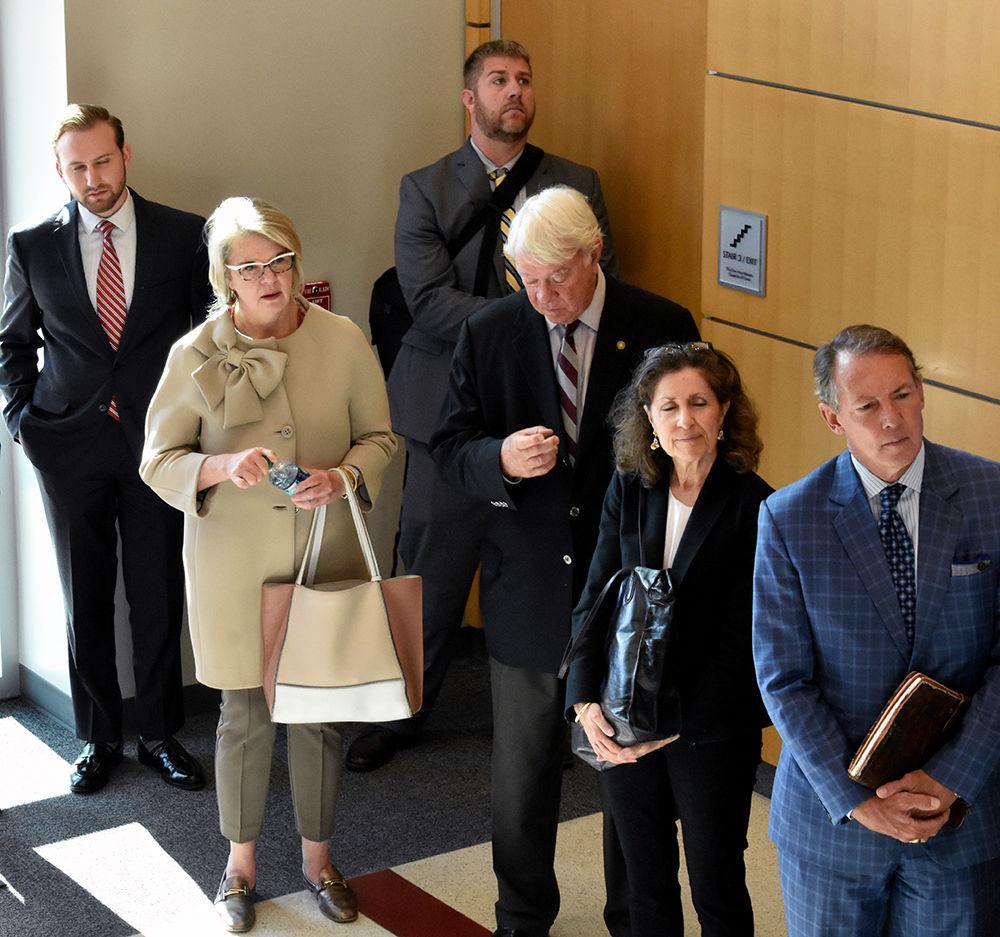 UNC System President Margaret Spellings visits Centennial Campus with student representatives Wednesday, Aug. 30. The group went to the College of Textiles and the Institute of Advanced Analytics. They stopped at Talley Student Union for lunch after a bus tour." />
UNC System President Margaret Spellings visits Centennial Campus with student representatives Wednesday, Aug. 30. The group went to the College of Textiles and the Institute of Advanced Analytics. They stopped at Talley Student Union for lunch after a bus tour." />
Priyanka Kundeshwar
UNC System President Margaret Spellings visits Centennial Campus with student representatives Wednesday, Aug. 30. The group went to the College of Textiles and the Institute of Advanced Analytics. They stopped at Talley Student Union for lunch after a bus tour.
UNC System President Margaret Spellings and the UNC System Board of Governors visited campus for an orientation session guided by Chancellor Randy Woodson Wednesday. The visit touched on many long-term goals that the Board of Governors envisions for the UNC System over the next five years and served to showcase NC State as a system leader in STEM research and education.
“They say we’re not supposed to show you the expensive buildings,” Woodson jokingly told the Board. “Because then you’ll think that we have too much money to spend.”
The tour of campus began in the morning at the Monteith Engineering Research Center with a presentation on wearable technology being developed by ASSIST labs at NC State.
Woodson explained that the Monteith Engineering Research Center was the only facility on the Centennial Campus leg of the tour that was paid for with public funds; the other locations were paid for by partnering with industry leaders who, according to Woodson, “see real potential in the work that we’re doing here.”
During the wearable technology presentation, Spellings and other members of the Board of Governors had the opportunity to try on a watch powered entirely by body heat, followed by a live demonstration of clothing that measures the wearer’s vital signs while exercising.
During a 2-pound weight lifting portion of the demonstration, Frank Grainger, the longest-serving member of the Board of Governors, joked that he, the subject, should try a heavier weight.
Following the tour of the Monteith building, the group donned safety glasses as they were led through the Nonwovens Institute and shown a hallway full of presentations by students within the College of Textiles.
The group was then led to the Alliance Building for a presentation on NC State’s Institute for Advanced Analytics from the program’s director, Michael Rappa. Woodson talked on the program’s 10-year history and current Master of Science in Analytics class size of 120, compared to 40 in its first year. Woodson’s explanation of the program drew a “Wow!” from the impressed Spellings.
The chancellor went on to explain that Jim Goodnight, founder of SAS, was instrumental in the establishment of the IAA, but Goodnight jokingly told Woodson that graduates from IAA were too qualified, and he could not afford to pay their salaries. During the presentation, Goodnight said that the average annual salary of an IAA graduate is $95,000.
“This is something that the Board of Governors should support,” Goodnight said.
The presentation ran parallel to many goals laid out by the Board of Governors in its 2017-2022 Strategic Plan for the UNC System. Throughout the plan’s goals, the need for ─ and current lack of ─ accurate, comprehensive data and analytics systems is stressed.
In her January 2017 report to the Board discussing the Strategic Plan, Spellings said, “Right now, we have a lot of information, but our ability to mine it lags where we need to be.”
During the presentation, three themes were stressed: innovation, immersion and intensity. Board member and three-term Raleigh Mayor Tom Fetzer commented that these principles have been used in education for centuries.
“The world’s first two great educators, Aristotle and Socrates, used the same educational principles,” Fetzer said. “Anyone who studies a foreign language knows that immersion is the best way to learn.”
When Rappa explained the demographics of the IAA graduate program, Board member Darrell Allison questioned the representation of students from historically black colleges and universities in one of NC State’s top programs.
“The UNC System has some of the premier HBCUs in the nation,” Allison said. “How are those students being represented in this program?”
Rappa explained that the program has had success recruiting from HBCUs within the UNC System, and “about a half-dozen” undergraduates from North Carolina Agricultural & Technical University have been admitted into the MSA program in its 10-year history.
Spellings followed Allison’s question by asking, “What kind of diversity are we seeing in this program?”
“We have a very diverse population from about 20 countries of origin,” Rappa said. The IAA’s class of 2018 is made up of 35 percent minority students, according to the class’s admissions report.
The first goal listed in UNC System’s Strategic Plan is to “increase enrollments and completion of and completions by underserved students, including those from low-income families, rural counties, and others who are underserved for any reason.” The first step to completing this goal, Spellings said, is updating the UNC System’s data systems.
Following the presentation, Spellings spoke with Rappa for a few minutes to discuss collaboration between NC State’s Institute for Advanced Analytics and the Board to accomplish the UNC System’s long-term goals.
Expounding upon the topic of diversity in the UNC System, Spellings said that the success of minority, rural and low-income students is a vital and ongoing goal, one that goes hand-in-hand with the goal of improved data systems.
Spellings remarked that these demographics cannot be improved if they cannot be accurately measured.
“What gets measured gets done,” Spellings said.